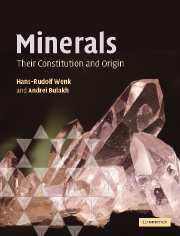Book contents
- Frontmatter
- Contents
- Preface
- Acknowledgments
- Figure credits
- Part I Structural features of minerals
- Part II Physical investigation of minerals
- 7 Experimental studies of crystal structures. X-ray diffraction
- 8 Physical properties
- 9 Optical properties
- 10 Identification of minerals with the petrographic microscope
- 11 Color
- 12 Additional analytical methods
- 13 Mechanical properties and deformation
- Part III Variety of minerals and mineral-forming processes
- Part IV A systematic look at mineral groups
- Part V Applied mineralogy
- Appendices
- Glossary
- References
- Index
- Plate section
- References
10 - Identification of minerals with the petrographic microscope
from Part II - Physical investigation of minerals
- Frontmatter
- Contents
- Preface
- Acknowledgments
- Figure credits
- Part I Structural features of minerals
- Part II Physical investigation of minerals
- 7 Experimental studies of crystal structures. X-ray diffraction
- 8 Physical properties
- 9 Optical properties
- 10 Identification of minerals with the petrographic microscope
- 11 Color
- 12 Additional analytical methods
- 13 Mechanical properties and deformation
- Part III Variety of minerals and mineral-forming processes
- Part IV A systematic look at mineral groups
- Part V Applied mineralogy
- Appendices
- Glossary
- References
- Index
- Plate section
- References
Summary
Sample preparation
The use of a polarizing microscope to analyze the optical properties of crystals is a standard technique in mineralogy and petrography. Not only is the petrographic microscope used for identification of mineral species, but it can also help to determine structural and chemical variations in minerals – for example, in solid solutions. Every student of earth sciences should become familiar with this technique and have at least some experience with a petrographic microscope. There are two approaches to such optical studies. One approach is utilized for transparent crystals that are analyzed with transmitted light. The second is used for opaque crystals. In this approach, a modified polarizing microscope is used and light is reflected from a highly polished surface and then analyzed using similar methods as for transmitted light. In the following discussion we will confine ourselves to the first method, which is known as transmitted light microscopy. In order to follow the concepts and applications introduced in this chapter, you need to have access to a petrographic microscope and some thin sections. They are available in most geology departments. You can also, as a substitute, consult a recently distributed CD that simulates a microscope (Christiansen, 2001).
Most minerals as they occur in rock samples are, at best, translucent. For example, if we put a chip of granite or basalt under the microscope, no light is transmitted. Thus, in order to transmit light, one of two methods must be applied.
- Type
- Chapter
- Information
- MineralsTheir Constitution and Origin, pp. 181 - 207Publisher: Cambridge University PressPrint publication year: 2004



